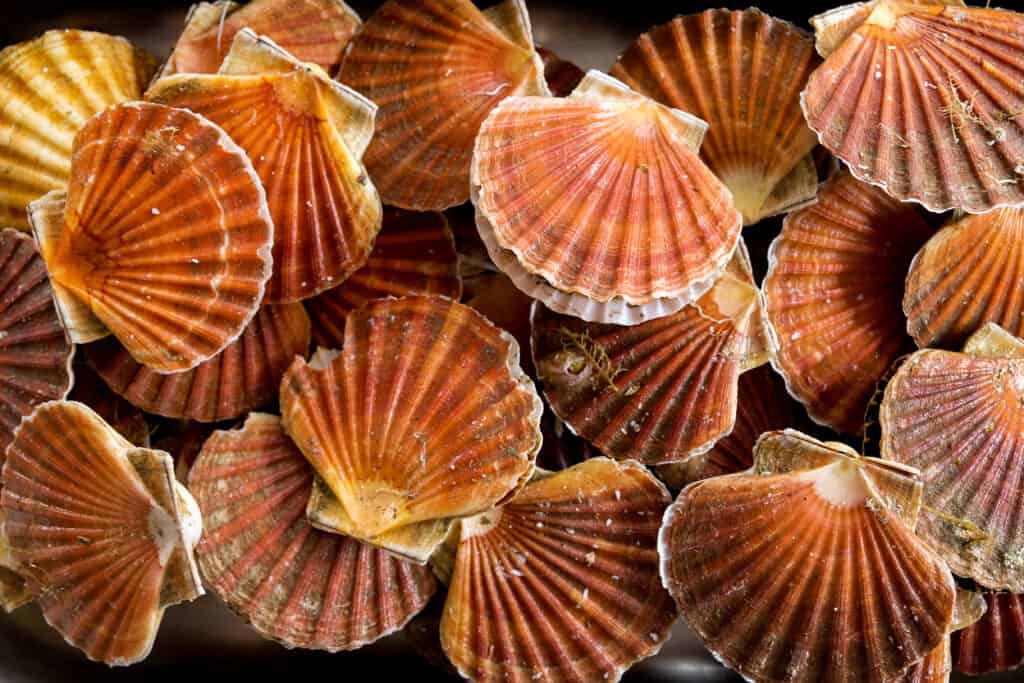Scallops
Pectinidae
Scallops begin their lives by attaching to sea grass on the ocean floor.
Advertisement
Scallops Scientific Classification
- Kingdom
- Animalia
- Phylum
- Mollusca
- Class
- Bivalvia
- Order
- Pectinida
- Family
- Pectinidae
- Genus
- Pectinidae
- Scientific Name
- Pectinidae
Read our Complete Guide to Classification of Animals.
Scallops Conservation Status
Scallops Facts
- Fun Fact
- Scallops begin their lives by attaching to sea grass on the ocean floor.
- Biggest Threat
- Change in habitat
- Most Distinctive Feature
- They are bivalves that have two shells connected by a hinge.
- Habitat
- Ocean
- Predators
- Sea stars, lobsters, crabs, fish
Scallops Physical Characteristics
- Color
- Grey
- White
- Skin Type
- Shell
- Lifespan
- Up to 20 years
- Venomous
- No
- Aggression
- Low
View all of the Scallops images!
If you like to eat seafood, you should definitely learn more about tasty Scallops!
These bivalve mollusks are popular in many seafood dishes. They live in saltwater and are caught off the coast of the eastern United States and Canada by commercial fishing companies. Scallops include multiple species within the same family. Some swim through the water while others stay in one place attached to the sea floor. But all have two shells that protect their intricate body structures.
Scallops Facts
Scallops eat plankton and krill by filtering ocean water.
These mollusks are actually an entire family, known as Pectinidae, that includes over 300 species.
Scallops have as many as 200 eyes, which they use to monitor their environment for potential predators, food sources, and other changes.
Popular in cooking, Scallops are often seared or grilled to keep their meat tender and flavorful. Overcooking can result in rubbery meat.
Some species of Scallops have distinct male and female specimens. Others are hermaphrodites and possess both male and female parts within the same animal. Still others start life as males and morph into females.
Classification and Scientific Name
The entire family Pectinidae refers to scallops, which include multiple genera and species. All scallops are bivalves. This means that they live within a hinged shell with two pieces. “Pectin” in Latin means “comb,” which refers to the type of shell that Scallops use. They belong to the superfamily Pectinoidea. This superfamily also includes spiny oysters. Sometimes they are referred to as Scallops but they are actually a different animal.
There are more than 300 species of Scallops. While they all share a similar structure and live in similar environments, they are diverse and live all over the world. There is even fossil evidence of these bivalves from more than 240 million years ago, during the Triassic Period.
They belong to the Pectinida order. Other members of this order are also bivalves, including clams and other bivalve mollusks. Scallops are part of the Bivalvia class, which was also called the Lamellibranchiata or Pelecypoda class. Some live exclusively in salt water, like the scallops, and others live in freshwater. Scallops are part of the Mollusca phylum within the Animalia kingdom. Mollusks have around 85,000 species although many have not been studied.
Scallop Appearance
Scallops are bivalves with two shells. They are connected via a hinge and use their adductor muscles to open and close their shells. This large muscle is a significant portion of their structure. They also have eyes, small tentacles, intestines, and gills. Their internal structure is quite complex, although because it is small, it is hard for most people to recognize the various parts. The adductor muscle and the ovary are the two largest structures. Both are used in cooking.
While Scallops do have a nervous system, they don’t have a brain. Instead, they use three ganglia to send nerve impulses throughout their bodies. The visceral ganglia are the largest and send the most impulses. They are located in the center of the internal structure.
Scallops’ eyes are very small and not recognizable as eyes to people used to mammals, fish, and other species. They have around 200 eyes, which are located all around the perimeter of their body. They likely can’t see as clearly as humans but they do use their eyes to detect changes in the environment. This can include differences in light and dark, movement of potential predators nearby, and changes in the particles of the water that indicate more or less available food.
Some species of Scallops produce pearls, refining grains of sand or dirt inside their shells over time. They are duller and do not have the same iridescence that pearls from oysters or other mollusks often have.

The shell of the Scallop is symmetrical, consisting of two hinged pieces.
©Gill Copeland/Shutterstock.com
Distribution, Population, and Habitat
With so many species within the family, Scallops can be found in many parts of the world. Notably, all species of Scallops live in saltwater; they do not live in freshwater. The Indian Ocean and Pacific Ocean are home to more species than most other areas.
Scallops tend to live in shallower water but some species can also swim through deep ocean areas. As young Scallops, they often attach to a substrate to stay in one place. Some species keep this behavior through their adult lives as well. Others learn to swim and propel themselves through the water.
Predators and Prey
There are many species of ocean animals that like to eat Scallops. Fish, lobsters, crabs, and sea stars are all common predators. Species that feed on mollusks often eat Scallops, although they do need to be able to open their shells.
Scallops are also considered a tasty dish in many cultures. Fishing for them is commercially viable, although steps are taken to ensure that scallops are harvested sustainably.
They have gills so scallops eat plankton and krill from their environment. They have adapted to survive on various food sources. Some species swim through their environment as adults, eating as they go. Others stay in one place and filter ocean water through their gills to get food.
Reproduction and Lifespan
Scallops have a large reproductive organ called “coral” in their bodies. In the males, it is white. In females, it is dark orange. The eggs inside are called “roe” and are popular in cooking. Some species have separate males and females. Others are hermaphrodites and have both male and female reproductive parts within the same animal. Some begin their lives as males and transition to females as they mature.
Fertilized eggs are distributed on the bottom of the sea floor. When they hatch, they are called larvae. They grow into juveniles, called spat. Eventually, the spat fall to the bottom of the ocean where they continue to build their shells. They attach themselves to sea grasses. Some species remain this way for their entire lives while others eventually detach.
The layers of shell can help researchers know how old a Scallop is. They build their own shells using calcium, protein, and other nutrients that they produce and get from their environment. Some species live only a few years while others can live for 20 years or more.
Scallops in Fishing and Cooking
Scallops are a popular seafood dish. They are tender and sweet and can take on the flavors of other ingredients with which they are cooked. The adductor muscle and the coral are two parts of the scallop that are eaten. The adductor muscle can be seared or grilled, as well as poached or steamed. Scallops should not be overcooked and only need a few minutes on each side.
When preparing Scallops, you can find them still intact in their shell or with the meat already separated from the rest of the Scallop. If you get them fresh from harvesting, you will need to shuck them. To do this, open the shell using a sharp, specialized knife and then cut the meat away from the shell.
Atlantic sea scallops, Placopecten magellanicus, are the most popular Scallops for fishing. They are caught commercially using dredging and trawling off the coast of the eastern United States and Canada. Some areas have seen a decline in the number of them. This is mostly due to a change in their habitat. When there are fewer sea grasses for the spat to attach to, their lifecycle is significantly disrupted. Spat seeding and efforts to reduce overfishing have helped to increase their numbers.
Similar Mollusks to Scallops
Clams: These are also bivalve mollusks that are edible and popular in many seafood dishes. They live in both saltwater and freshwater habitats.
Oysters: These bivalves live in saltwater like scallops. They have irregular-shaped shells. The spiny oyster is closely related to the scallop.
View all 293 animals that start with SScallops FAQs (Frequently Asked Questions)
What part of a scallop is not edible?
The only edible parts are the adductor muscle, called the meat, and the roe. This means that the shell, eyes, gills, and most of the other internal structures such as the digestive system are not common in food preparation.
What are the three different types of scallops?
In cooking, there are three main types of scallops. These include bay scallops, sea scallops, and calico scallops. This refers to the place where they are found or the pattern on their shell. Scientifically, there are over 300 species of scallops.
How long do scallops need to cook?
Most recipes call for scallops that are seared quickly. If you are searing them in a pan or on a grill, cook them for around 5 minutes per side once the cooking surface is hot. This will vary by thickness and size of the scallops.
Thank you for reading! Have some feedback for us? Contact the AZ Animals editorial team.
Sources
- SMAST Fisheries, Available here: http://www.smast.umassd.edu/Fisheries/Scallops/lifehistory.htm#:~:text=Sea%20scallops%20have%20many%20natural,of%20predation%20of%20sea%20scallops.
- USF Water Institute, Available here: https://www.sarasota.wateratlas.usf.edu/scallops/#sarasota-scallops
- Great British Chefs, Available here: https://www.greatbritishchefs.com/how-to-cook/how-to-cook-scallops#:~:text=To%20shuck%20scallops%20(prise%20the,discarded%20but%20is%20actually%20edible.

















